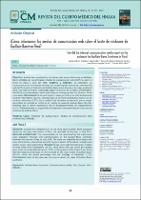¿Cómo informaron los medios de comunicación web sobre el brote de síndrome de Guillain-Barré en Perú?
Related Resource(s)
http://cmhnaaa.org.pe/ojs/index.php/rcmhnaaa/article/view/874Date
2021-05-24Author(s)
Granados-Castañeda, Luciana Rocío
Pantoja-Costa, Alexandra Romina
Leguía-Cerna, Juan Alberto
Díaz Vélez, Cristian
Metadata
Show full item recordAlternate title
How did the internet communication media report on the outbreak the Guillain-Barre Syndrome in Peru?
Abstract
Objetivo: Analizar las características de las noticias sobre el síndrome de Guillain-
Barré emitidas por los principales medios de comunicación web del Perú, sobre el
brote en mayo a julio del 2018. Material y Métodos: Se analizaron las
características de las noticias emitidas por los principales medios de comunicación
web del Perú sobre el Síndrome de Guillain-Barré entre los meses de mayo a julio del
2018. Las noticias fueron clasificadas según valoración de la noticia (informativa,
educativa y con elevada percepción del riesgo de contagio y muerte), alcance, fecha
y encuadre. Resultados: Se encontró que el mayor porcentaje de noticias fueron de
carácter informativo (25,7%), mientras que las de menor porcentaje fueron las de
carácter educativo (7,8%). En el análisis del encuadre se encontró que el mayor
porcentaje de noticias se centró en el reporte de casos de Guillain-Barré (56,4%),
mientras que el menor porcentaje fue el desabastecimiento de medicamentos
(2,2%). Conclusiones: La mayoría de noticias fueron informativas sobre los casos de
síndrome de Guillain-Barre. Objetive: Analyze the characteristics of the news about Guillain-Barré syndrome
issued by the main web media in Peru, the outbreak during May to July 2018.
Material and Methods: The characteristics of the news issued by the main media
were analyzed. Peruvian web communication on the Guillain-Barré Syndrome
between the months of May to July 2018. The news was classified according to the
news (informative, educational and with high perception of the risk of contagion and
death), scope, date and framing. Results: It was found that the highest percentage
of news items were informative (25.7%), while those with the lowest percentage
were those of an educational nature (7.8%). In the analysis of the frame it was found
that the highest percentage of news focused on the case report of Guillain-Barré
(56.4%), while the lowest percentage was the shortage of medicines (2.2%).
Conclusions: Most of the news was informative about the cases of Guillain-Barre
syndrome.






